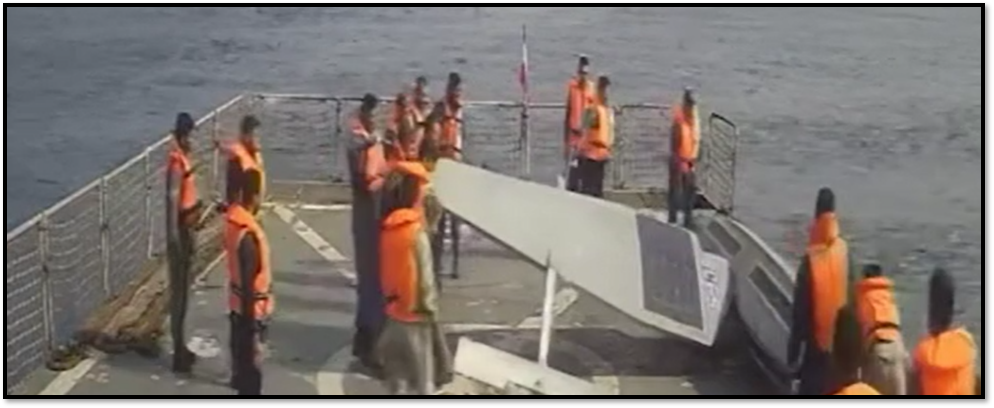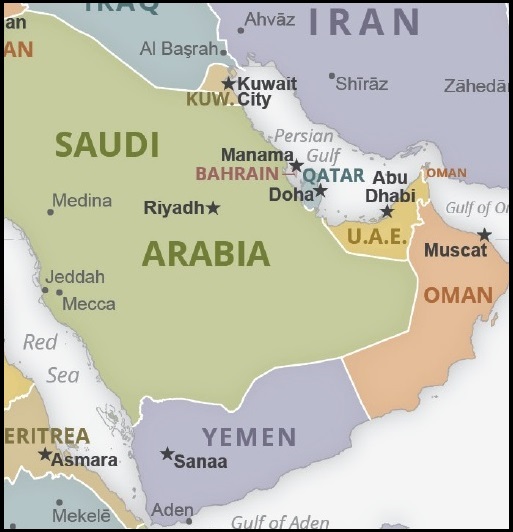In two provocative incidents just days apart, Iranian naval forces briefly seized three U.S. drones collecting data in the international waters of the Persian Gulf and the Red Sea. The seizures coincided with growing tensions between the United States and Iran over militia activities in Syria and Iraq as well as stalled diplomacy designed to revive the 2015 nuclear agreement.
[2 of 3] Here is a video showing support ship Shahid Baziar, from Iran's Islamic Revolutionary Guard Corps Navy unlawfully towing a U.S. Saildrone Explorer unmanned vessel in international waters of the Arabian Gulf, Aug. 30. pic.twitter.com/12qveGsJS7
— U.S. Central Command (@CENTCOM) August 30, 2022
Overnight on August 29, the Shahid Baziar, a support ship in the Revolutionary Guards Navy, seized a U.S. Saildrone Explorer drone equipped with sensitive radar, sensors and cameras in the Persian Gulf. “This incident once again demonstrates Iran’s continued destabilizing, illegal, and unprofessional activity in the Middle East,” Michael “Erik” Kurilla, the head of Central Command said in a statement.
The Iranian ship released the U.S. craft four hours after a U.S. warship and helicopter approached. The seizure was “flagrant, unwarranted and inconsistent with the behavior of a professional maritime force,” Vice Admiral Brad Cooper, commander of naval forces in the U.S. 5th, said in a statement. “U.S. naval forces remain vigilant and will continue to fly, sail and operate anywhere international law allows while promoting rules-based international order throughout the region.”
On September 1, an Iranian destroyer, the Jamaran, seized two other Saildrone Explorers in the Red Sea, loaded them aboard, and covered them with tarp. The Jamaran is part of the Iranian Navy fleet, which operates separately from the Revolutionary Guards. The United States dispatched two guided-missile destroyers as well as helicopters in response. Iran released the drones the next day on September 2.
A U.S. official said that the cameras were missing from the drones but could not say if Iranian forces had removed them or if they had fallen off. The camera systems used on the drones are sold on commercial markets and do not store classified material.
No live fire was exchanged in either incident. But U.S. military leaders have long warned that naval encounters can escalate quickly.

Historically, most of the hostile encounters between U.S. and Iranian naval forces have involved the Revolutionary Guards. Its fast boats have often harassed larger U.S. vessels, although not necessarily as part of an orchestrated military operation. “The activities we typically see from the IRGC Navy are not necessarily activities that are directed by the supreme leader or from the Iranian state, rather irresponsible actions by local commanders on the scene,” General Kenneth F. McKenzie Jr., then head of U.S. Central Command, said in April 2021.
Drones have become a mainstay of the U.S. Navy since Task Force 59 was established to support 5th Fleet operations out of Bahrain in 2021. The force includes underwater, airborne and surface drones. The Saildrone Explorer is a solar-powered drone, approximately 16 feet tall and 23 feet long, and is equipped with artificial intelligence capabilities. It is designed to conduct long-range data collection operations.
 “We want to put more systems out in the maritime domain above, on and below the sea,” Cooper said when the new Task Force was announced in September 2021. “We want more eyes on what’s happening out there.” The 5th Fleet is responsible for patrolling an area 2.5 million square miles of water that spans the strategic Strait of Hormuz, the Suez Canal, and the Strait of Bab el Mandeb, which connects the Red Sea to the Gulf of Aden. Some 20 percent of the world’s traded oil passes through the Strait of Hormuz.
“We want to put more systems out in the maritime domain above, on and below the sea,” Cooper said when the new Task Force was announced in September 2021. “We want more eyes on what’s happening out there.” The 5th Fleet is responsible for patrolling an area 2.5 million square miles of water that spans the strategic Strait of Hormuz, the Suez Canal, and the Strait of Bab el Mandeb, which connects the Red Sea to the Gulf of Aden. Some 20 percent of the world’s traded oil passes through the Strait of Hormuz.
The United States has also exerted its military muscle in the region. On September 4, two days after the drone seizures, two U.S. B-52 bombers flew across the eastern Mediterranean, Arabian Peninsula and Red Sea in a complex training mission. They were accompanied by Saudi, Kuwait, British, and Israeli warplanes and supported by 16 nations. “The U.S. does not seek conflict but continues to be postured and committed to respond to any contingency” in the territory where U.S. Central Command operates, the Air Force said. In August 2022, U.S. forces also launched airstrikes on Iran-backed militias in Syria in response to drone and rocket attacks on bases housing U.S. troops.
The separate drone seizures also overlapped with intense diplomacy, launched in April 2021, to revive full U.S. and Iranian compliance with the Iran nuclear deal. The following is a timeline of U.S.-Iran naval encounters in 2022.
Timeline: U.S.-Iran Naval Encounters 2022
April 2, 2021: Four Revolutionary Guards ships approached two U.S. Coast Guard ships, the Monomy and the Wrangell, in the southern Persian Gulf. The Harth 55 came within 70 yards of the U.S. ships and repeatedly crossed their front bows. After approximately three hours of U.S. warnings and defensive maneuvers, the Revolutionary Guard vessels “maneuvered away from the U.S. ships and opened distance between them,” the U.S. Navy said. In past incidents, U.S. ships were harassed by smaller Iranian vessels.
April 26, 2021: The USS Firebolt, a patrol boat, fired warning shots after three IRGC fast-attack boats came within 68 yards of it and the Baranoff, a U.S. Coast Guard patrol boat. The incident occurred in the international waters of the Persian Gulf. U.S. vessels had not fired a warning shot on Iranian ships since July 2017.
May 10, 2021: The Maui, a U.S. Coast Guard cutter, fired 30 warning shots after 13 IRGC Navy fast boats came within 150 yards of six U.S. military vessels that were escorting the guided-missile submarine USS Georgia. “This activity is the kind of activity that could lead to somebody getting hurt and could lead to a real miscalculation there in the region, and that doesn’t serve anybody’s interests,” Pentagon spokesperson John Kirby said. The IRGC denied the U.S. account and said that the U.S. warning shots were “provocative.”
Nov. 10, 2021: An Iranian naval helicopter circled the USS Essex in the Gulf of Oman. The incident did not impact Essex operations, “but that doesn't mean that this wasn't an unsafe and unprofessional act,” Kirby said. “Tehran needs to be pressed on why they thought this was a prudent use of their pilots and their aircraft to fly so dangerously close to a U.S. warship.”
June 20, 2022: Three IRGC fast-attack boats nearly collided with two U.S. Navy Ships, the USS Sirocco and Choctaw County, in the Strait of Hormuz. The ships approached at a “dangerously high speed” and came within 50 yards of the Choctaw County, which fired a warning flare, the U.S. Navy reported. The incident lasted for about an hour. “We have seen not only in recent days but over the course of many weeks and months that Iran has engaged in maritime activity that is unsafe, that is unprofessional, that puts sailors at risk,” State Department Spokesperson Ned Price said on June 21.
Aug. 29-30, 2022: The Shahid Baziar, an IRGC Navy support ship, seized a U.S. Saildrone Explorer in the international waters of the Persian Gulf. The Iranian ship released the U.S. craft four hours later.
Sep. 1 and 2, 2022: The Jamaran, an Iranian Navy destroyer, seized two U.S. Saildrone Explorers in international waters of the Red Sea. Iran released the drones 18 hours later. The drones’ cameras were missing, but a U.S. official could not say whether Iran had removed them or they had fallen off.
